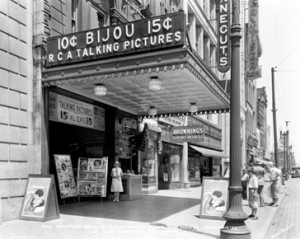The Paleface — Bob Hope singing “Buttons and Bows” and Jane Russell, well, being Jane Russell — is my earliest memory of seeing a motion picture show. I saw the film with my parents at The Indiana. A few years later I was old enough to join over 500 of my closest Irvington friends for the Saturday “kiddie matinee” at the Irving Theater. Between The Three Stooges and a full hour of color cartoons was Invaders from Mars; I slunk down in my seat and covered my eyes several times. Many a happy Saturday afternoon followed, sitting in the darkness watching the larger-than-life images on the silver screen.
While moving pictures had been shown in Indianapolis prior to 1906 at theaters primarily devoted to vaudeville such as the Grand Opera House, the first theater built specifically for showing moving pictures was the Bijou Theatre, 108 E. Washington St. One of the early “photo-plays” shown at the Bijou was “a beautiful production of The Life of Moses”; admission was 10ȼ (2016: $2.71). Later in the year the Dreamland Penny Arcade, 17 S. Illinois St, and the Vaudette Theater, 19 S. Illinois St, were drawing movie audiences.
Store-front theaters soon filled the downtown district, and within a decade over two dozen “photo-play” houses could be found only a few blocks from Monument Circle. Among these were the Isis and the Lyric in the second block of North Illinois; the Nu Sho at 131 S. Illinois and the Family at 17 Kentucky Av. With over a third of the city’s moving picture venues, Washington Street was the “theatre district” — the Bijou and the Gayety on East Washington and the Alhambra, 42 W. Washington; the Lyceum, 148 W. Washington; the Gem, 225 W. Washington; the Eagle, 310 W. Washington; the Star, 404 W. Washington; and the Best, 430 W. Washington. In 1913 Indianapolis Star theater critic Hector Fuller wrote, “…since the advent of moving pictures most of the first-class theaters might as well shut up their galleries. It is from the gallery and the cheaper seats in the balcony of the regular theaters that the moving pictures have drawn their patronage and it is just these people who, very often, constitute the difference between profit and loss.”
This success led to rooms of 200-folding chairs being transformed like the Lyric into 1,400-permanent seat auditoriums, and the opening of Indianapolis’ first “moving picture palace” — the 3,000 seat Circle Theater — in 1916. Clad in a gleaming white terra cotta façade with a lighted marquee and Clifton Wheeler’s graceful pastoral Grecian mural above, the Circle’s interior was equipped with luxurious appointments of marble and mahogany dominated by a “magnificent chandelier of bronze and amber glass.” Across its stage hung a “great satin damask drop curtain” that was raised for the opening performance of Home. The eve of “the talkies” in the late 1920s found two other great moving picture palaces — the Indiana and the Walker — opening to the city’s film patrons. The Indiana Theater on West Washington Street, with an intricately designed terra cotta façade of Spanish motif above a vast sparkling lighted marquee, opened on June 18, 1927 featuring The Prince of Headwaiters. Six months later, the Walker Theatre at 603 Indiana Av, a tan-brick flatiron structure with African inspired art deco terra cotta ornamentation, opened with a showing of The Magic Flame.
Color movies arrived in Indianapolis with the showing of The Toll of the Sea at the Ohio Theater, 40 W. Ohio St, in March 1923. This was the second feature length film by the Technicolor Motion Picture Corporation. Five years later, a Circle Theater ad proclaimed, “See and Hear Al Jolson in The Jazz Singer,” and Indianapolis moviegoers saw and heard the first feature-length sound film that began its week-long run on February 4, 1928. The golden age of film at the city’s downtown theaters soon followed. Early in 1953 ads promoting “A Lion In Your Lap – A Lover In Your Arms” drew audiences to the Indiana to don special glasses to view Bwana Devil, the first color “3 Dimension — 3-D” film. Later in the decade the introduction of wide screen movies in CinemaScope and Cinerama continued to bring crowds to the grand theaters.
In addition to motion pictures, the larger downtown theaters, from time to time, were also venues for live stage performances. Twice I went to the Circle Theater for such presentations. The first time was in January 1958 when the stage adaptation of the 300-year old Oberammergau Passion Play came to Indianapolis on its American tour. The second time was over twelve years later and at the other end of the theatrical spectrum in the “Age of Aquarius” when the musical Hair opened a month long engagement on October 19, 1970. Yes, I went up on stage at the end of the performance with several hundred members of the audience to join members of the cast in dancing; the stage did not collapse.
Gradually the dancing lights on the downtown theater marquees began to dim, eventually going out altogether with the closing of the Circle Theater in the fall of 1981. Fortunately, the Indiana Theater and the Circle Theater buildings gained new life as the home of the Indiana Repertory Theater in the former and the Indianapolis Symphony Orchestra in the latter. Movie-goers would not return to downtown Indianapolis, however, until September 1995 with the opening of the United Artists Circle Centre Theatre (now Regal Cinema), a multi-screen theater in Circle Center Mall.
Next – Kiddie Matinee Afternoons.



